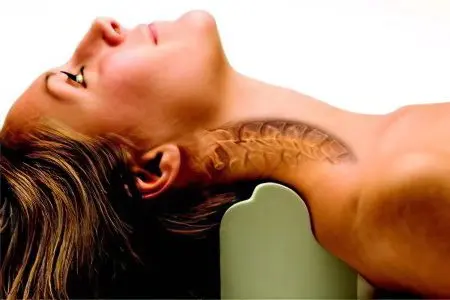Contents
Kyphosis of the cervical spine – This is a rare pathological curvature of the cervical vertebrae. Kyphosis refers to the backward curve of the neck. This condition cannot be ignored, since it entails a disruption in the functioning of many organs, including the brain, which will experience oxygen starvation.
The development of this pathology in a person of any age and gender is not excluded.
Causes of kyphosis of the cervical spine

Causes of kyphosis of the cervical spine can be as follows:
Congenital anomalies in the structure of the cervical vertebrae. Their arches may not be fused together, or there may be a defective atlantoaxial articulation between the occiput and the C2 and C1 vertebrae.
Muscle paralysis, which is most often observed with cerebral palsy.
Transferred rickets in childhood.
Degenerative-dystrophic changes in the spinal column.
Vertebral deformities caused by infectious diseases – tuberculosis or spondylitis.
old age. Various diseases that worsen in people in old age lead to kyphosis. In orthopedics, there is such a thing as “senile back”, which includes cervical kyphosis.
Risk factors include Bechterew’s disease and osteochondrosis.
Spinal injuries.
Herniated discs.
Malignant and benign neoplasms of the spinal column.
Incorrect body position while studying or working at a computer.
Dorsal juvenile kyphosis.
Symptoms of cervical kyphosis
Symptoms of kyphosis of the cervical spine are primarily associated with the location of the pathology and are expressed by the following clinical signs:
Decreased mobility of the neck.
The occurrence of crepitus of the cervical vertebrae when trying to turn the head.
If the vertebral artery is pinched, headaches will be observed with localization in the back of the head. Possible hearing and vision impairment. Problems with coordination of movements occur when the vestibular apparatus is damaged. Symptoms increase during an attempt to turn the head.
Pain can occur in the form of an electric shock, which is called the phenomenon of Lermitte’s pain. The process involves the neck, both upper limbs and the spine.
The flexion-extensor reflex disappears in the elbow joint.
The skin sensitivity of the face (Zelder zone) worsens, which will be associated with damage to the trigeminal nerve.
Due to a violation of the blood supply to the brain, a person develops dizziness, darkening in the eyes, fainting is possible.
General performance suffers, thinking, memory, attention and other cognitive processes are disturbed.
Jumps in blood pressure with its fall and rise are fixed.
Of particular danger is myelopathy with infringement of the vertebral artery, which saturates part of the brain with blood. Symptoms increase gradually. The patient begins to complain of a feeling of cold in the hands, of their numbness. Then the tics of the fascia join, muscle weakness increases.
Perhaps the development of paralysis, both central and peripheral, which occurs with strong clamping of the nerve roots. Sometimes this provokes urination disorders.
The patient begins to stoop, his neck hump forms, which occurs due to the protrusion of sharp vertebrae.
As the disease progresses, the thoracic region is involved in the pathological process, which entails problems with the respiratory and cardiovascular systems.
Diagnosis of cervical kyphosis
Diagnosis of cervical kyphosis for an orthopedist is not difficult. As a rule, its presence can be assumed only on the basis of a standard examination and a survey of patient complaints.
Nevertheless, it is possible to clarify the degree of curvature of the spine, to determine the strength of compression of the nerve endings and the vertebral artery, only with the help of such research methods as:
Target radiography.
X-ray of the cervical spine in two projections, you may need a picture of the entire spine as a whole.
Passing an MRI.
Treatment of kyphosis of the cervical spine

Treatment of kyphosis of the cervical spine should be based on the elimination of the cause that provoked the problem:
To eliminate kyphosis, which was caused by violations of posture, it will be necessary to teach the patient to maintain the correct body position while walking and while sitting. There are specialized exercise therapy that make it possible to correct posture. Corsets are not used in this case.
With dorsal youthful kyphosis, massage, exercise therapy, and the help of a chiropractor will be required. It is possible to wear a corset. If conservative methods fail to correct the deformity angle, then surgical intervention is indicated with the obligatory presence of a neurosurgeon.
Congenital kyphosis is treated mainly with the help of an operation performed even in childhood. It is important to reliably stabilize the vertebrae in order to prevent the progression of the disease in the future. Often, it is impossible to do without repeated interventions, since the child’s spine is constantly growing and stretching.
With kyphosis caused by cerebral palsy, poliomyelitis and other paralysis and muscle paresis, you will need the help of a chiropractor, exercise therapy, and physiotherapy. Surgical intervention is required if it is impossible to eliminate severe pain, or if the functioning of the brain, respiratory organs, etc. is impaired.
A fracture of the cervical vertebra is a very dangerous injury. It is she who most often leads to the formation of kyphosis and is manifested by many other negative consequences. Situations in which the spinal cord is damaged are especially dangerous. Treatment is predominantly surgical.
In osteoporosis, osteochondrosis and other degenerative changes in the spinal column, adhere to a conservative treatment regimen aimed at preventing the progression of the disease.
So, the main methods of treating kyphosis of the cervical spine are: exercise therapy, massage, manual therapy, physiotherapy. Surgical intervention is required when the disease progresses and it is impossible to eliminate negative symptoms in a conservative way.









